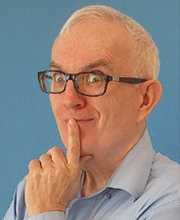Embrace Miscellaneous Organization for Your Ideas
Jeff Copper with Rick Green
Download PDF
The topic of getting organized comes up frequently in coaching, and I can relate to that personally. For instance, there’s a “miscellaneous” drawer in my kitchen. It’s the depository for things that don’t have a home. The top drawer of my bedroom chest serves the same purpose. Ditto my workbench in the garage.
 If something is unique and I don’t know where it goes, I put it in the miscellaneous drawer. If I need something that doesn’t have a home, I rummage through that drawer. That’s well and good for organizing tangible items, but the question is, how do you organize thoughts? What do you do with them so you can find them later?
If something is unique and I don’t know where it goes, I put it in the miscellaneous drawer. If I need something that doesn’t have a home, I rummage through that drawer. That’s well and good for organizing tangible items, but the question is, how do you organize thoughts? What do you do with them so you can find them later?
While I have my own challenges and theories of what such things look like, I’ve often wondered about others. So, I asked other ADHD thought leaders about their systems. I had a hunch that most of them have the same struggles, but I was hoping that maybe just one had a perfect system.
The responses were very similar, but one in particular caught my eye. It was so well articulated and seemed to communicate my exact system so metaphorically, that it just may be the universal system among creatives. That response was from Rick Green, CHADD Hall of Fame member and founder of RickWantsToKnow.com. With his permission, I’m sharing his response.
“How do I capture ideas?
I have to admit, not well. I have so many ways to capture ideas. Too many. And it’s exhausting. I say that because retrieving them is a problem. Did I write it on a Post-it? On a scrap of paper? Could I have I recorded it as a voice memo on my phone? Is it on one of the twelve lists that are piled on my desk? Or the twenty-three lists on the other desk? Is it on the bulletin board? Is it in a file folder? If so, which file drawer? One of the six in my office or the twelve in the basement? Could it be in a Word document on my computer? What was the title? What key words did I use? How can I find it again?
It’s bad. How bad? I have come across a note with an idea for a video (or a document with six ideas) and one jumps out at me and so I start writing it. Only later, after I’ve finished a first draft, or a second, a third, or actually recorded it, do I find that I’d already written a script around this idea. And when I read it I’m either relieved, “Oh, what I recorded was much better than this,” or else I am disappointed because there are a couple of really great lines that I would love to include.
That’s the worst-case scenario. The best case? I have an idea and I open a document and start writing. Throwing down a few ideas, capturing some thoughts, a funny line, a clever observation, and perhaps a couple of choice quotes from the seventy experts we’ve interviewed over the years. Just getting it down, basically bullet points. The key is to label the document, so when I search for it, it shows up. I used to create funny or clever titles that were intriguing. But had little or nothing to do with the content. “The Best Lesson I Learned From Mrs. Femson” doesn’t help me if I’m looking for the idea I had about finding a hobby that is complex enough to keep you intrigued.
Now I have learned to label the documents with keywords only. The name of the document is not necessarily the title of the video, blog, or presentation.
But for capturing ideas on the fly that come to me at odd times, I definitely rely on the voice memo app on my phone. We also use an app (I think it’s an app?) called Trello where we can track all of the current projects and capture ideas for blogs, videos, etc. David Riddles, our one employee (you only need one when you have David), is great at capturing requests from our patrons and putting those into the appropriate column. Trello is like an online version of a huge bulletin board of 3×5 cards that you can capture anything on. Only each card can be expanded with all kinds of options to include references, descriptions, steps involved, deadlines, contacts, etc.
The challenge is not that I need ways to capture ideas, it’s that I have too many and I don’t stick with them. Sound familiar?”
In October 2014, Attention magazine published an article I wrote titled “Ugly Organizational Systems.” The point of the article was to highlight that being “organized” is knowing where things are. Something might look like a pile of clutter, but if you know where everything is in the pile, it is organized. All too often we associate organization with being aesthetically pleasing.
I wrote the article in the hope that many adults with ADHD would feel validated. That validation would give them permission to acknowledge they were, in fact, organized. Organization can be pretty, but it doesn’t have to be. Even if your system looks ugly, it doesn’t mean you are not organized. If you can find what you’re looking for, you are organized.
Rick Green’s narrative of his system echoes the ugliness of organizing one’s thoughts. I really identify with his description and have come to accept that, by definition, my system is all over the place because that’s what a miscellaneous idea organization system looks like. In that realization, I feel validated in accepting my system for what it is.
My thanks to Rick Green on behalf of so many people who may read this article, identify with it, and find some peace in their miscellaneous system to organize thoughts.
 Jeff Copper, MBA, PCC, PCAC, is an ADHD coach, founder of DIG Coaching Practice, and the host of Attention Talk Radio and Attention Talk Video. He coaches his clients to help them realize their potential in business and personally. Having learned to manage attention and deal with his own challenges, Copper developed his anatomy of attention construct to help his clients control their attention and move past barriers. He holds an MBA from the University of Tampa, professional designations from ICF and PAAC, and certifications from ADD Coach Academy and Coaches Training Institute. Copper serves on the editorial advisory board of Attention magazine.
Jeff Copper, MBA, PCC, PCAC, is an ADHD coach, founder of DIG Coaching Practice, and the host of Attention Talk Radio and Attention Talk Video. He coaches his clients to help them realize their potential in business and personally. Having learned to manage attention and deal with his own challenges, Copper developed his anatomy of attention construct to help his clients control their attention and move past barriers. He holds an MBA from the University of Tampa, professional designations from ICF and PAAC, and certifications from ADD Coach Academy and Coaches Training Institute. Copper serves on the editorial advisory board of Attention magazine.
 Graduating with a bachelor of science degree in physics, Rick Green became a demonstrator and program developer at the Ontario Science Centre. Eventually, he dove into comedy full time as a writer, actor, director, and producer, and worked on 700 episodes of television and radio programs, including The Red Green Show, Sexual Intelligence with Kim Catrall, Prisoners of Gravity, and The Frantics. In 2009, Rick and his wife, Ava, created the award-winning PBS documentary, ADD & Loving It?! which eliminated stigma and busted endless myths by combining solid scientific information with humor, humanity, and hope. Focusing on the relationship between fellow comedian Patrick McKenna and his wife Janis, the program was life-changing for millions of people. ADD & Loving It?! ran on PBS for over ten years. What began as a one-time project became a full-time mission, leading to a website, TotallyADD.com, featuring webinars, videos, and blogs. Green also created sixteen full-length videos featuring ADHD specialists, doctors, researchers, coaches, and advocates. With the original documentary ending its run, Green expanded his focus to address procrastination, emotional sensitivity, creativity, organization, memory, depression, anxiety, mindfulness, and more, at RickWantsToKnow.com. For his work with people affected by ADHD, Rick Green has won numerous awards and was appointed to the prestigious Order of Ontario and the Order of Canada.
Graduating with a bachelor of science degree in physics, Rick Green became a demonstrator and program developer at the Ontario Science Centre. Eventually, he dove into comedy full time as a writer, actor, director, and producer, and worked on 700 episodes of television and radio programs, including The Red Green Show, Sexual Intelligence with Kim Catrall, Prisoners of Gravity, and The Frantics. In 2009, Rick and his wife, Ava, created the award-winning PBS documentary, ADD & Loving It?! which eliminated stigma and busted endless myths by combining solid scientific information with humor, humanity, and hope. Focusing on the relationship between fellow comedian Patrick McKenna and his wife Janis, the program was life-changing for millions of people. ADD & Loving It?! ran on PBS for over ten years. What began as a one-time project became a full-time mission, leading to a website, TotallyADD.com, featuring webinars, videos, and blogs. Green also created sixteen full-length videos featuring ADHD specialists, doctors, researchers, coaches, and advocates. With the original documentary ending its run, Green expanded his focus to address procrastination, emotional sensitivity, creativity, organization, memory, depression, anxiety, mindfulness, and more, at RickWantsToKnow.com. For his work with people affected by ADHD, Rick Green has won numerous awards and was appointed to the prestigious Order of Ontario and the Order of Canada.
Other Articles in this Edition
Screen Time and Sleep During the Pandemic
Eight Ways to Stop Taking Things So Personally
Reading Comprehension and Executive Function
Compensatory and Recovery Services for Students with ADHD
Executive Function Issues and ADHD
Growing College Success from First Semester Failure
